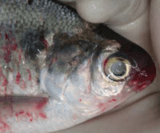Fin rot
Fin rot is a symptom of disease or the actual disease in fish. This is a disease which is most often observed in aquaria and aquaculture, but can also occur in natural populations.[1]
Fin rot can be the result of a bacterial infection (Pseudomonas fluorescens, which causes a ragged rotting of the fin), or as a fungal infection (which rots the fin more evenly and is more likely to produce a white 'edge'). Sometimes, both types of infection are seen together. Infection is commonly brought on by bad water conditions, injury, poor diet, or as a secondary infection in a fish which is already stressed by other disease.
Fin rot starts at the edge of the fins, and destroys more and more tissue until it reaches the fin base. If it does reach the fin base, the fish will never be able to regenerate the lost tissue. At this point, the disease may attack the fish's body directly.
Fin rot is common in bettas due to poor water conditions in pet stores.
Symptoms
- Fin edges turn black / brown
- Fins fray
- Base of fins inflamed
- Entire fin may rot away or fall off in large chunks
Treatment
- Change the water and check the filter
- Treat with a suitable treatment such as phenoxyethanol, malachite green methylene blue or other proprietary agent[2]
- Use aquarium salt, 1 tbsp per 5 U.S. gallons
- Find out the pH and correct it if necessary.
- Use milafix if the rotting is jagged.
- use pimafix if rot is jagged and has holes.
Prevention
- Make sure the water is good quality
- Feed fresh food in small portions
- Maintain constant water temperature
References
- ↑ "Ninth Flatfish Biology Conference". Nefsc.noaa.gov. December 1–2, 2004. p. 68. Retrieved 2012-10-13.
- ↑ Bailey, Mary; Burgess, Peter (1999). Tropical fishlopaedia : a complete guide to fish care. Lydney, Gloucestershire: Ringpress. ISBN 186054102X.
External links
- Fin rot: Symptoms and Treatment at AquaDaily
- Diagnosis, prevention and treatment information at the Aquarium Wiki
